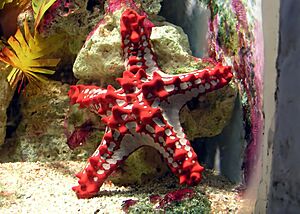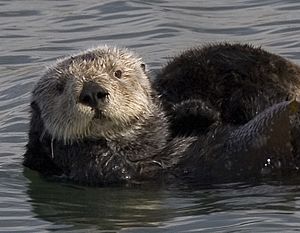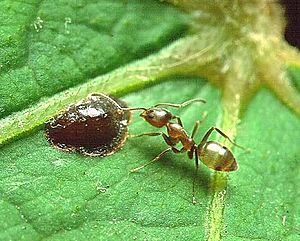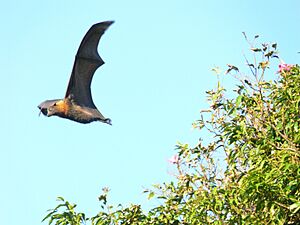Ecological extinction facts for kids
Ecological extinction happens when a species is still around, but its numbers are so low that it no longer plays its important role in its natural home. Even if a few individuals are left, they don't interact much with other species.
This idea is important for protecting nature. If a species doesn't interact much with others (for example, as a predator, helper, or prey), its loss might not change the community much. But if it does, its loss can cause big problems.
Scientists also talk about two other types of extinction:
- Global extinction means a species has completely disappeared from everywhere.
- Local extinction means a species has disappeared from only part of its natural home.
Contents
Keystone Species
The idea of a keystone species was first described by Robert Paine in 1969. He studied how the predatory sea star (Pisaster ochraceus) affected the numbers of a snail called Tegula funebralis. This study took place in the rocky areas along the coast of Washington.
Paine removed all sea stars from certain areas for two years. He found that removing this top predator reduced the number of different species in those areas. Paine defined a keystone species as one that has a much bigger effect on its environment than you would expect from its size or how many there are. This idea of a keystone species helps us understand ecological extinction.
Examples of Ecological Extinction
Scientists looked at the role of the sea otter in kelp forests. In a 1978 study, they compared islands with and without sea otters. They wanted to see if sea otters controlled populations of creatures like sea urchins. Sea urchins eat kelp.
The study found that where sea otters were present, there were fewer sea urchins. This meant the kelp forests were healthy because the urchins weren't eating all the kelp. When sea otters were missing, sea urchins ate so much kelp that the forests almost disappeared. Kelp forests are important homes for fish and eagles.
Historically, too many sea otters were hunted for their fur. This greatly reduced their numbers. Now, scientists are seeing how these local disappearances of otters have affected the environment.
The California spiny lobster (Panulirus interruptus) is another keystone predator. It helps keep different species in its habitat. In 1987, scientists showed that if spiny lobsters were removed, mussels took over the habitat. This shows how losing a keystone predator can reduce the variety of species in an ecosystem. Overfishing has caused local disappearances of the California spiny lobster.
Commercial oyster fishing greatly changed the Chesapeake Bay ecosystem. When mechanical dredges were used in the 1870s, it led to overfishing of oysters. Today, the bay suffers from too much algae, which makes the water low in oxygen. These algal blooms have pushed out many other species that used to live there, like dolphins, manatees, and sea turtles. This shows how removing a keystone species, like the oyster, can harm the entire marine ecosystem.
Invasive Species
Scientists studied the potential ecological extinction of guanacos (Lama guanicoe) and lesser rheas (Pterocnemia pennata) in Argentine Patagonia. These native animals are important food for local predators. However, they are being replaced by introduced species like the European rabbit, red deer, and domestic cattle.
These introduced species also eat a lot, which further damages the already shrinking grasslands. Scientists found that native predators, from skunks to pumas, now mostly eat these introduced animals. This suggests that guanacos and rheas are no longer common enough to be important prey. They have become ecologically extinct in this area.
It's possible that the new species compete too much with the native ones for food. The introduced animals also change the plants in the habitat. This could make the competition even worse. Guanacos and rheas are not globally endangered, but this doesn't show that they are no longer playing their role in Patagonia. This loss could affect how plants and animals interact and how nutrients move through the ecosystem. This example shows how current conservation efforts might not fully protect species because they don't consider their functional role.
Seed dispersal is crucial for plants to grow and for the community to continue. A study in 2001 showed changes in plant communities in South African shrublands after the Argentine ant (Linepithema humile) arrived. Ants help spread up to 30% of the plants in these areas. They bury large seeds, protecting them from predators and fire. This burial is important because most seeds sprout after a fire.
Argentine ants, however, do not spread even small seeds. The study found that after a fire, fewer large-seeded plants grew in areas invaded by Argentine ants. This will eventually lead to small-seeded plants taking over. This change in plant community shows the struggle for large-seeded plants to spread. This problem could affect many places worldwide, as ants are major seed dispersers.
Modeling Ecological Extinction
A 2006 study tried to create a model for ecological extinction. They looked at how flying foxes spread seeds from large trees on tropical Pacific Islands. Insular flying foxes (Pteropus tonganus) are considered keystone species because they are the only animals that can carry large seeds far distances. Trees need this dispersal to survive, especially in tropical areas where diseases can affect seeds near the parent tree.
The study found a tipping point for flying fox numbers. Below a certain number, seed dispersal was very low, no matter how many flying foxes there were. But above that number, more flying foxes meant more seeds were spread.
Scientists think this happens because flying foxes are territorial. If there aren't many flying foxes, they might eat within one tree, dropping seeds right below it. But if there are many flying foxes, they might fight over fruit. This aggressive behavior could lead to seeds being carried farther away. So, flying foxes have a huge effect on the community structure, even if there aren't a huge number of them. Modeling these effects is the first step to using this idea in conservation.
Scientists are still learning about the important interactions within an ecosystem. They need to find the right number of a species needed to keep the ecosystem balanced. Knowing how much a species interacts with its environment will help conservation efforts be more effective. This is especially important on islands, where there are fewer other species to take over a specific role. As species diversity and habitats shrink worldwide, finding the most crucial species for an ecosystem will be key to protecting nature.
Climate Change
Climate change has caused many changes in where species live and how many there are. A 2004 study estimated the risk of extinction due to these changes. Their model suggested that 15–37% of species could be "committed to extinction" by 2050. This is based on predictions for global warming over the next 50 years.
Even though the average global temperature has risen, individual populations respond to local climate changes. Scientists suggest that local climate changes can cause shifts in population numbers, changes in the timing of events (like flowering), changes in body size, and shifts in genetic makeup. They found that on average, spring events are happening 5.1 days earlier. This shift is stronger in northern areas, where local temperatures have changed the most.
Losing habitats, losing animals that help plants (like pollinators), and the effect of introduced species all put pressure on native populations. These problems don't happen alone; they work together. Climate change can make all these problems worse. For example, a study found 16 new types of warm-water phytoplankton in the North Sea, north of their usual range. This was linked to changes in ocean temperature. All these effects add stress to populations. The more complete definition of ecological extinction must be considered in efforts to prevent species loss.
Protecting Nature
Conservation policy often falls behind new scientific discoveries. But now, it's crucial for leaders to catch up to prevent huge extinctions. For example, the main American conservation law, the Endangered Species Act of 1973, doesn't fully consider the benefit of protecting species that greatly interact with others and help maintain overall species diversity.
To improve policy, we need to ask: "Does losing this species cause a loss of overall diversity? Does it affect other species' reproduction? Does it change the habitat structure, or how nutrients move? Does it change important ecological processes, or make the ecosystem less able to handle problems?"
After answering these questions to define an interactive species, we need to figure out the right number of that species needed to keep its important interactions going. This process is similar to estimating how many individuals a population needs to survive. So, it shouldn't be too hard to add to current policies. To avoid a mass extinction on a global scale, scientists must understand all the reasons why species are disappearing. Governments around the world must act now to stop this loss of biodiversity from getting worse.
See also
- Argentine ant
- California spiny lobster
- Climate change
- Ecological threshold
- Extinction
- Flying fox
- Guanaco
- Keystone species
- Rhea
- Sea otter





